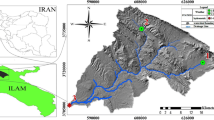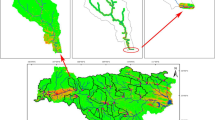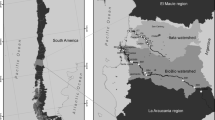Abstract
Increasing land utilization through diverse forms of human activities, such as agriculture, forestry, urban growth, and industrial development, has led to negative impacts on the water quality of rivers. To find out how catchment attributes, such as land use, hydrologic soil groups, and lithology, can affect water quality variables (Ca2+, Mg2+, Na+, Cl−, HCO −3 , pH, TDS, EC, SAR), a spatio-statistical approach was applied to 23 catchments in southern basins of the Caspian Sea. All input data layers (digital maps of land use, soil, and lithology) were prepared using geographic information system (GIS) and spatial analysis. Relationships between water quality variables and catchment attributes were then examined by Spearman rank correlation tests and multiple linear regression. Stepwise approach-based multiple linear regressions were developed to examine the relationship between catchment attributes and water quality variables. The areas (%) of marl, tuff, or diorite, as well as those of good-quality rangeland and bare land had negative effects on all water quality variables, while those of basalt, forest land cover were found to contribute to improved river water quality. Moreover, lithological variables showed the greatest most potential for predicting the mean concentration values of water quality variables, and noting that measure of EC and TDS have inversely associated with area (%) of urban land use.





Similar content being viewed by others
References
Ahearn DS, Sheibley RW, Dahlgren RA, Anderson M, Johnson J, Tate KW (2005) Land use and land cover influence on water quality in the last free-flowing river draining the western Sierra Nevada, California. J Hydrol 313(3–4):234–247
Amiri BJ, Nakane K (2006) Modeling the relationship between land cover and river water quality in the Yamaguchi Prefecture of Japan. J Ecol Field Biol 29(4):343–352
Amiri BJ, Nakane K (2008) Entire catchment and buffer zone approaches to modeling linkage between river water quality and land cover—a case study of Yamaguchi Prefecture, Japan. Chinese Geogr Sci 18(1):85–92
Atkinson S, Johnson D, Venables B, Slye J, Kennedy J, Dyer S, Price B, Ciarlo M, Stanton K, Sanderson H (2009) Use of watershed factors to predict consumer surfactant risk, water quality, and habitat quality in the upper Trinity River, Texas. Sci Total Environ 407(13):4028–4037
Baker A (2003) Land use and water quality. Hydrol Process 17(12):2499–2501
Bruijnzeel LA, Sampurno SP (1990) Hydrology of moist tropical forests and effects of conversion: a state of knowledge review. The Netherlands: Faculty of Earth Sciences, Free University, Amsterdam, p 224
Carey RO, Migliaccio KW, Li Y, Schaffer B, Kiker GA, Brown MT (2011) Land use disturbance indicators and water quality variability in the Biscayne Bay Watershed, Florida. Ecol Indic 11(5):1093–1104
Chen J (1987) Water environment chemistry. Higher Education Press, Beijing
Dale VH, Brown S, Haeuber RA, Hobbs NT, Huntly N, Naiman RJ, Riebsame WE, Turner MG, Valone TJ (2000) Ecological principles and guidelines for managing the use of land. Ecol Appl 10(3):639–670
Dyksterhuis EJ (1949) Condition and management of rangeland based on quantitative ecology. J Range Manag 2(3):104–115
Haidary A, Amiri BJ, Adamowski J, Fohrer N, Nakane K (2013) Assessing the impacts of four land use types on the water quality of wetlands in Japan. Water Resour Manag 27(7):2217–2229
Harrington BA, Humphreys G (2004) Plant accessible phosphorus as a discriminator of native vegetation in the upper Blue Mountains. Supersoil: 3rd Australian New Zealand Soils Conference, 5–9 December 2004
Holloway J, Dahlgren R, Hansen B, Casey W (1998) Contribution of bedrock nitrogen to high nitrate concentrations in stream water. Nature 395(6704):785–788
Kaste O, Henriksen A, Hindar A (1997) Retention of atmospherically-derived nitrogen in subcatchments of the Bjerkreim River in southwestern Norway. Ambio 26(5):296–303
Li S, Zhang Q (2008) Geochemistry of the upper Han River Basin, China, 1: spatial distribution of major ion compositions and their controlling factors. Appl Geochem 23(12):3535–3544
Li S, Gu S, Liu W, Han H, Zhang Q (2008) Water quality in relation to land use and land cover in the upper Han River Basin, China. Catena 75(2):216–222
Li S, Gu S, Tan X, Zhang Q (2009) Water quality in the upper Han River basin, China: the impacts of land use/land cover in riparian buffer zone. J Hazard Mater 165(1–3):317–324
Maillard P, Pinheiro Santos NA (2008) A spatial-statistical approach for modeling the effect of non-point source pollution on different water quality parameters in the Velhas River watershed—Brazil. J Environ Manag 86(1):158–170
McCulloch JS, Robinson M (1993) History of forest hydrology. J Hydrol 150(2–4):189–216
Miller JD, Schoonover JE, Williard KW, Hwang CR (2011) Whole catchment land cover effects on water quality in the Lower Kaskaskia River watershed. Water Air Soil Pollut 221(1–4):337–350
Pacific Southwest Interagency Committee (PSIAC) (1968) Report of the Water Management Subcommittee on Factors Affecting Sediment Yield in the Pacific Southwest Area and Selection and Evaluation of Measures for Reduction of Erosion and Sediment Yield. ASCE 98, Report No. HY12
Pratt B, Chang H (2012) Effects of land cover, topography, and built structure on seasonal water quality at multiple spatial scales. J Hazard Mater 209–210:48–58
Rzhevsky V, Novick G (1971) The physics of rocks. MIR, Moscow, 320pp
Seitz NE, Westbrook CJ, Noble BF (2011) Bringing science into river systems cumulative effects assessment practice. Environ Impact Assess 31(3):172–179
Sliva L, Williams D (2001) Buffer zone versus whole catchment approaches to studying land use impact on river water quality. Water Res 35(14):3462–3472
Uriarte M, Yackulic CB, Lim Y, Arce-Nazario JA (2011) Influence of land use on water quality in a tropical landscape: a multi-scale analysis. Landsc Ecol 26(8):1151–1164
USDA, Natural Resources Conservation Service (2007) Hydrologic soil groups. National Engineering Handbook. http://directives.sc.egov.usda.gov/viewerFS.aspx?hid=21422. Accessed 23 Nov 2013
Versace V, Ierodiaconou D, Stagnitti F, Hamilton A, Walter M, Mitchell B, Boland A-M (2008) Regional-scale models for relating land cover to basin surface-water quality using remotely sensed data in a GIS. Environ Monit Assess 142(1–3):171–184
Water Resources Management Company (WRMC) of Iran (2009) Guidelines for monitoring surface water quality variables. WRMC of Iran, Tehran
Yang X, Jin W (2010) GIS-based spatial regression and prediction of water quality in river networks: a case study in Iowa. J Environ Manag 91(10):1943–1951
Zampella RA, Procopio NA, Lathrop RG, Dow CL (2007) Relationship of land-use/land-cover patterns and surface-water quality in the Mullica river basin. J Am Water Resour Assoc 43(3):594–604
Zhou T, Wu J, Peng S (2012) Assessing the effects of landscape pattern on river water quality at multiple scales: a case study of the Dongjiang River watershed, China. Ecol Indic 23:166–175
Acknowledgments
It is acknowledged the initial datasets in our study were supplied by WRMC, Forest, Ranges and Watershed Management Organization, Geological Survey of Iran, and Soil and Water Research Institute. Our special thanks to Drs. S. Feiznia and F. Sarmadian, as well as Mr. Hamid Barzegari, for their valuable assistance in lithological and soil type classifications. The authors wish to thank Dr. Jan Adamowski for English proofreading of the manuscript and the anonymous reviewer whose comments and views helped improve this paper.
Author information
Authors and Affiliations
Corresponding author
Additional information
Responsible editor: Philippe Garrigues
Rights and permissions
About this article
Cite this article
Hasani Sangani, M., Jabbarian Amiri, B., Alizadeh Shabani, A. et al. Modeling relationships between catchment attributes and river water quality in southern catchments of the Caspian Sea. Environ Sci Pollut Res 22, 4985–5002 (2015). https://doi.org/10.1007/s11356-014-3727-5
Received:
Accepted:
Published:
Issue Date:
DOI: https://doi.org/10.1007/s11356-014-3727-5




